At Weedom we believe Creator God allowed us to grow up with the weeds out of Love. Dandelion’s sad tale is perhaps the most extreme herbal example of unrequited love. Among the most powerful and generous sources of food and medicine, this weed is also the one that receives the most persecution and decimation by chemical warfare. Those eeeevil home owners’ associations are absolutely genocidal against Dandelions. We’re not talking about just a little herbicide in the sidewalk cracks. It’s total scorched earth strategy. The nuclear option.
We rebel against the distant, HOA hegemony by blowing the Dandelion seeds into the air at regular intervals. When harvesting, we never grab the whole root. In the fall that’s practically impossible anyway. Therefore our Dandelions come back year after year, even in the garden. They bloom spring, summer, fall and sometimes even in winter. Where we cut grass, they stay short. In the cow poo they grow huge. In northernmost zone 6, Midwest U.S. dandelions are among the cold season’s first and last eats for the bees, because they persist, flattened to the ground through most or all of the winter, ready and willing to fire off a low blossom anytime a warm front blows through.
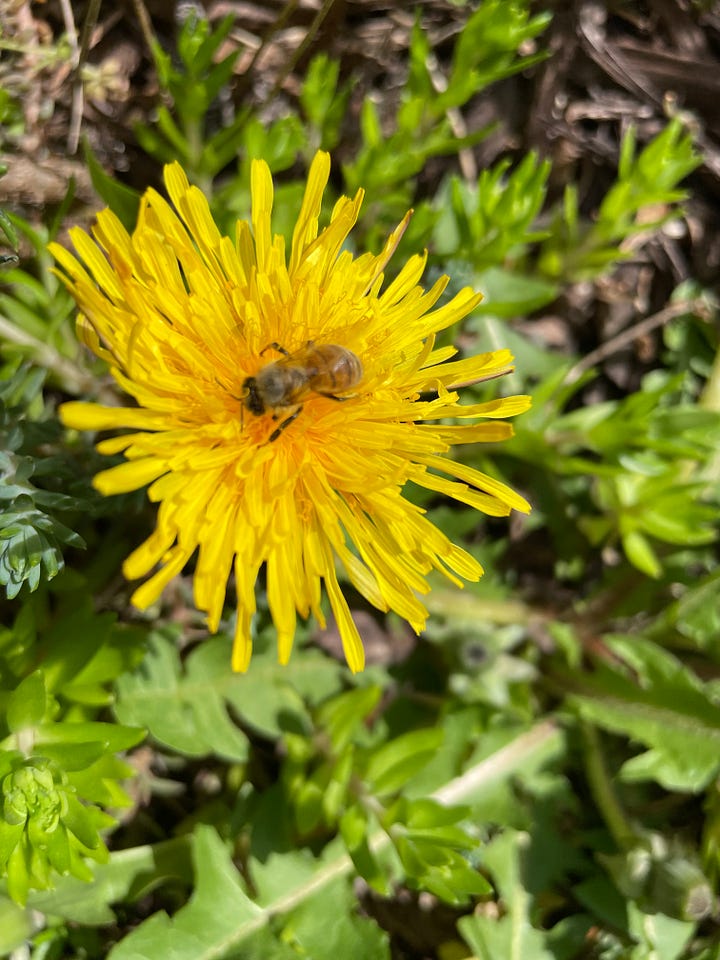
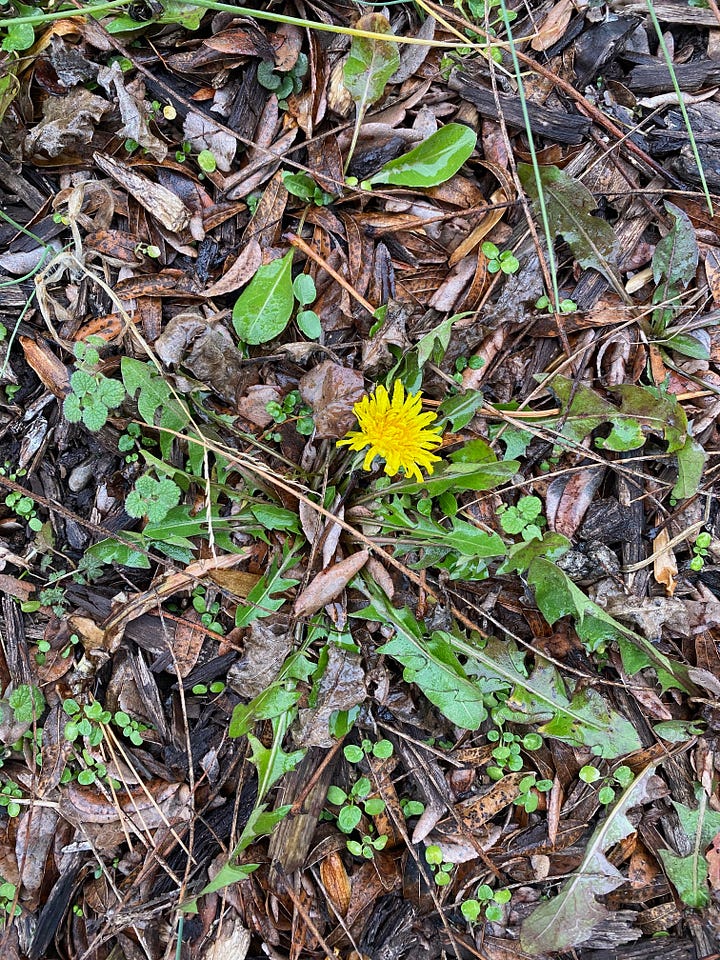
Dandelion are everywhere now, so we have to remind everyone to love them and pick them, make a salad and all sorts of dishes, and wine and jelly. Spread their seeds around. Remember this weed has the power to preserve us during the “zombie apocalypse”. When there’s a break in the herbal action, we will return to dandelions with more details, because we could write an encyclopedia….
Let’s do the dandelion botany: Taraxacum officinale, of the family, Asteraceae, is believed to have spread to North America via the Europeans. It was long used in Eurasia for food and medicine, but somehow its prolific nature caused it to become much maligned, abused and sprayed in the New World. This perennial weed exists always as a rosette, coming back year after year from deep tap roots. Leaves ranging from 2 to 14 inches long emerge directly from the base. They are lobed with large backward facing teeth which increase in size towards the outer end of the leaf. The leaves have a more rounded end, and are less deeply lobed when young, then become more jagged as they age. Leaf veins emerge in an irregular alternating manner from a large central vein. Leaves are mostly smooth, green with perhaps a few spiny hairs close to where they attach to the base. The hollow flower peduncle, arising from the base, (also called a scape) is mostly smooth with possibly some sparse hairs. Breaking the leaves or peduncle produces a milky sap which is irritating to the skin of some, but which some herbalists use to treat warts. The dandelion flower head is composed of all ray flowers (no central disc flowers). At maturity it produces many tiny dry dry fruits called achenes which contain a single seed. They have a bristly hairy end which allows the seeds to take flight when the wind or a person blows at the seed head.
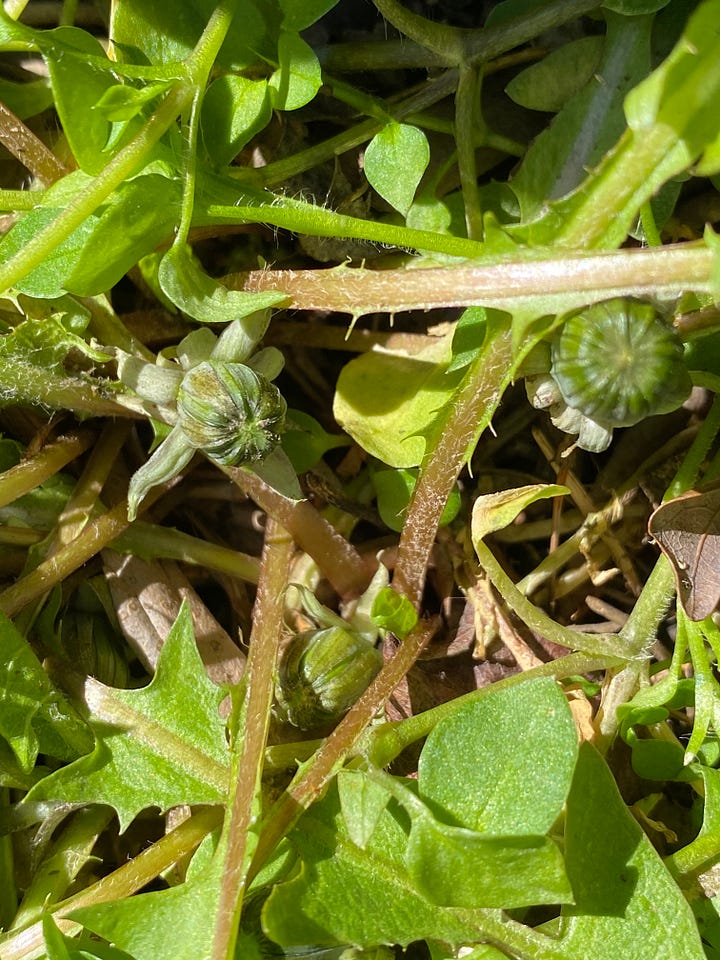
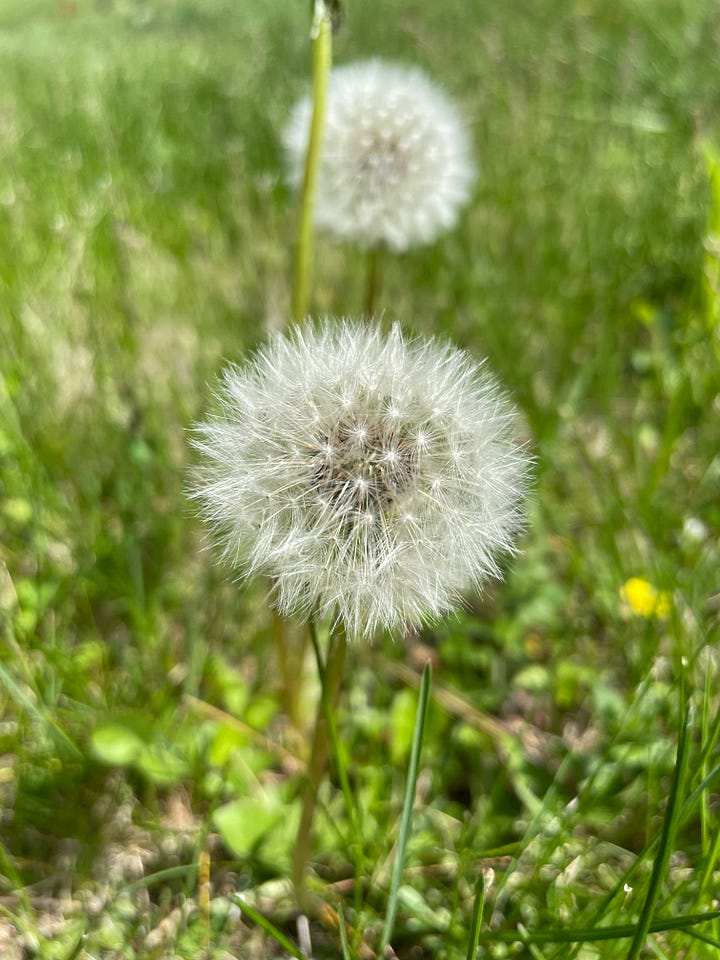
Some lookalike plants to Dandelion are the related chicory, Cichorium intybus, and various wild lettuce species, such as Lactuca sororia or virosa, etc. These might be confusing when they are young, but they are quite distinct once they grow up. All of those send up actual stems when they flower. The leaves of wild lettuce are grayer, a bit spiny and more rubbery to the touch. Chicory is really a type of endive. Leaves are similar to dandelion, but with more consistently sized lobes, and they are edible too. The chicory root can be used much like the dandelion root. Out in the Northwest U.S., there is Hawkweed, Hieracium spp., which are related to Chicory, and are dandelion lookalikes before they flower.
Most herbalists, (except for Patrick Jones DVM) don’t mention the industrial uses of dandelion as a source of rubber in WW-II when the natural rubber supply was cut off from Germany. Our Taraxacum officinale dandelion produces a stringy type of latex that’s not so easily adapted to industrial use. The Germans used the Russian dandelion, Taraxacum kok-saghyz which hails from Kazakhstan and Uzbekistan. After the war, the rubber tree sources were restored, and the use of dandelion faded. Now that some kind of fungus is killing the rubber trees in South America and S.E. Asia, interest in dandelion rubber is hot again. Some GMO Russian dandelions have been produced. This genetic modification reduces the activity of an enzyme, polyphenol oxidase. This prevents the latex from quickly coagulating, which allows much more product to be extracted from the dandelions. (One can imagine that these become single purpose weeds, as polyphenol oxidase likely mediates metabolic processes that produce plant medicine. Keep an eye on any large dandelion farms that pop up near your weed supply.) Check here if you want to learn more about dandelion rubber, and see a time lapse vid showing a dandelion flower transforming to a seed head. Bear in mind that Taraxacum kok-saghyz latex has been found to be cross reactive with that of the most prominently used type obtained from the Hevea brasiliensis rubber trees, so it is possible for those with a true latex allergy to have an allergic reaction to our dandelions too.
Some foragers find dandelions intolerable, but they’re likely grabbing them too late in the season. Early spring is the time for us. When the lower mid rib of the leaves are still green, the leaves are more acceptable for raw use, but they aren’t the sweet grocery store veggies. They have a some bitterness to them, If your body is needing them, you’ll likely be ready for the taste. Use of acidic (citrus or vinegar) dressings and sauces, as well as cooking mitigates the bitterness. Once you start seeing more purple in lower mid rib, think about making medicine instead. If you’re looking for beta-carotene as a precursor of vitamin A in your life, Dandelion leaves are a more concentrated source than carrots yielding 14,000 IU per 100 grams. You’ll notice that eating a lot of the leaves increases urination a good deal. French speaking Roselee de la Foret says that besides dent de lion “lion’s teeth” the other name for our weed is ‘pissenlit’, or ‘pee the bed’. But dandelion is a more perfect diuretic than pharma produces, because it supplies potassium, 7.6 mEq per 100 grams, helping to replace what is lost during the bathroom visits. More nutrients coming from the leaves are iron, calcium, magnesium, phosphorus, thiamine, riboflavin vitamins K, C and D, sodium, and fiber. Healthy!
When you’re using the flowers for jelly, wine and syrup, pull off most of the sepals, to reduce bitter flavor. The petals themselves are sweeter, and some pick up a nutty and vanilla flavor. Consider using the unopened flower buds as a caper substitute. Some people pickle or ferment these. When using flowers for oil infusion, ointment, or tincture, include the sepals too. The flavonoids and other constituents of the oil are helpful used topically for pain relief, and they are traditionally combined with such things as cottonwood buds and violet flowers to make massage oils and ointments. At weedom we lean towards allowing the flowers to wilt and using low heat to extract them into oil. Fully dried dandelion flowers can contain a good deal of fluff (that part which allows the seeds to fly) somewhat similar to dried arnica flowers. Some report more success by drying only those blooms which are just starting to open. As usual, drying has a significant effect on recovery of medicinal compounds. Think about tincturing fresh or wilted flowers with higher potency (50 or 60 %) alcohol to compensate for the moisture content. A whole plant tincture is preferred by those who want to cover all the bases medicinally.
The root is best collected in the fall after the first frost, when the plant has put more stored goodies such as inulin in the root, but help yourself anytime to the invasion if it’s taking over your garden. Shame to waste. The majority of inulin is stored in the roots, increasing from 2 percent to possibly 40 percent at the end of the growing season, and some of this compound is also present in leaves. Dandelion roots can be roasted similarly to chicory root, and ground to make a coffee substitute. Inulin is a collection of fructose containing polysaccharides of varying chain lengths. Some of the shorter ones, oligofructans, are credited with prebiotic activity to encourage beneficial gut flora. The activity of these beneficial bacteria inhibits absorption of compounds that cause fat deposits in the liver, accounting for part of the hepatoprotective effects attributed to dandelion. Specific polysaccharides TOP1 and TOP2 isolated from dandelion root were found to be preserve the livers of mice from acetaminophen injury. Additional liver protection by means of antioxidant and anti-inflammatory activity has been attributed to taraxol, taraerol, laevulin, luteolin, tannins, ascorbic acid, and various other flavonoids and phenolic compounds found in the roots and leaves of dandelion.
At weedom we emphasize an understanding of how the herbs do their work in the body. After a time of visiting here, you will have some background that allows you to rationally choose the best weeds for yourselves based upon actual constituents and their functions. This can help you to dodge allergies and interactions with allopathic meds that you might take. We must also be attentive to seasonality, so that you can physically familiarize yourselves with the herbs while they are growing. So we will introduce some more of the weeds of Spring before returning to dandelions to tell you about their many other activities and benefits. In the meantime we recommend checking out a few of the recipes from Ashley Adamant’s ginormous collection in order to work with dandelion in a manner that interests you most.
Don’t forget to tell your plant loving friends about weedom. Leave some comments. Share what you’re doing with the weeds. The readership of this new substack is growing, so it won’t be long before we open a chat and see if that is more comfortable than the comment section. Check out NOTES of substack to see comments from weedom and other writers, and interact with us.
Where We Dig
1. Di Napoli A, Zucchetti P. A comprehensive review of the benefits of Taraxacum officinale on human health. Bulletin of the National Research Centre. 2021;45(1):110. doi:10.1186/s42269-021-00567-1
2. Jalili C, Taghadosi M, Pazhouhi M, et al. An overview of therapeutic potentials of Taraxacum officinale (dandelion): a traditionally valuable herb with a reach historical background.
3. Crampton L. Common and Russian Dandelions: Nutrition, Latex, and Rubber. Owlcation. Published April 15, 2023. Accessed April 25, 2023. https://owlcation.com/stem/Natural-Latex-and-Rubber-From-Common-and-Russian-Dandelions
4. Dandelion Root vs. Dandelion Greens. Dr. Axe. Accessed April 25, 2023. https://draxe.com/nutrition/dandelion-root/
5. Stolze A, Wanke A, van Deenen N, Geyer R, Prüfer D, Schulze Gronover C. Development of rubber-enriched dandelion varieties by metabolic engineering of the inulin pathway. Plant Biotechnology Journal. 2017;15(6):740-753. doi:10.1111/pbi.12672
6. Maier K, Gladstar R. Energetic Herbalism - A Guide to Sacred Plant Traditions Integrating Elements of Vitalism, Ayurveda, and Chinese Medicine. Chelsea Green Publishing; 2021. https://openlibrary.org/books/OL34171771M/Energetic_Herbalism
7. Mohaddese M, Mahboubi M. Hepatoprotection by dandelion ( Taraxacum officinale ) and mechanisms. Asian Pacific Journal of Tropical Biomedicine. 2020;10:1. doi:10.4103/2221-1691.273081
8. Ganora L. Herbal Constituents, 2nd Edition - Foundations of Phytochemistry. Lulu Press, Inc.; 2021. https://openlibrary.org/books/OL35083771M/Herbal_Constituents_2nd_Edition
9. Cornish K, Xie W, Kostyal D, Shintani D, Hamilton R. Immunochemical Analysis of Latex Proteins from Rubber Dandelion Taraxacum kok-saghyz. In: ; 2015.
10. Hutchens AR. Indian Herbalogy of North America. Shambhala; Distributed in the United States by Random House; 1991. https://openlibrary.org/books/OL1567124M/Indian_herbalogy_of_North_America
11. Niness KR. Inulin and Oligofructose: What Are They? The Journal of Nutrition. 1999;129(7):1402S-1406S. doi:10.1093/jn/129.7.1402S
12. Pütter KM, van Deenen N, Unland K, Prüfer D, Schulze Gronover C. Isoprenoid biosynthesis in dandelion latex is enhanced by the overexpression of three key enzymes involved in the mevalonate pathway. BMC Plant Biol. 2017;17:88. doi:10.1186/s12870-017-1036-0
13. Hoffmann D. Medical Herbalism: The Science and Practice of Herbal Medicine. Healing Arts Press; 2003.
14. Grieve M. Modern Herbal. Echo Point Books & Media, LLC.; 2015. https://openlibrary.org/books/OL36722889M/Modern_Herbal
15. (PDF) Effect of Drying Methods on Phytochemicals, Antioxidant Activity and Total Phenolic Content of Dandelion Leaves. Accessed April 25, 2023. https://www.researchgate.net/publication/323914991_Effect_of_Drying_Methods_on_Phytochemicals_Antioxidant_Activity_and_Total_Phenolic_Content_of_Dandelion_Leaves
16. Cai L, Wan D, Yi F, Luan L. Purification, Preliminary Characterization and Hepatoprotective Effects of Polysaccharides from Dandelion Root. Molecules. 2017;22(9):1409. doi:10.3390/molecules22091409
17. DerMarderosian A, Buetler J. Review of Natural Products. 8th edition. Lippincott Williams & Wilkins; Facts and Comparisons; 2014. https://openlibrary.org/books/OL27960482M/Review_of_Natural_Products
18. Taraxacum officinale (common dandelion): Go Botany. Accessed April 24, 2023. https://gobotany.nativeplanttrust.org/species/taraxacum/officinale/
19. Taraxacum officinale (Dandelion, Lion’s Tooth) | North Carolina Extension Gardener Plant Toolbox. Accessed April 24, 2023. https://plants.ces.ncsu.edu/plants/taraxacum-officinale/
20. Jin YR, Jin J, Piao XX, Jin NG. The effect of Taraxacum officinale on gastric emptying and smooth muscle motility in Rodents. Neurogastroenterol Motil. 2011;23(8):766-e333. doi:10.1111/j.1365-2982.2011.01704.x
21. Easley T. The Modern Herbal Dispensatory - a Medicine-Making Guide.; 2016. https://openlibrary.org/books/OL26933940M/The_modern_herbal_dispensatory
22. This Fiber Improves Gut & Heart Health. Dr. Axe. Accessed April 25, 2023. https://draxe.com/nutrition/inulin/
23. De la Forêt R, Han E. Wild Remedies - How to Forage Healing Foods and Craft Your Own Herbal Medicine. Hay House Inc.; 2020. https://openlibrary.org/books/OL28333721M/Wild_Remedies





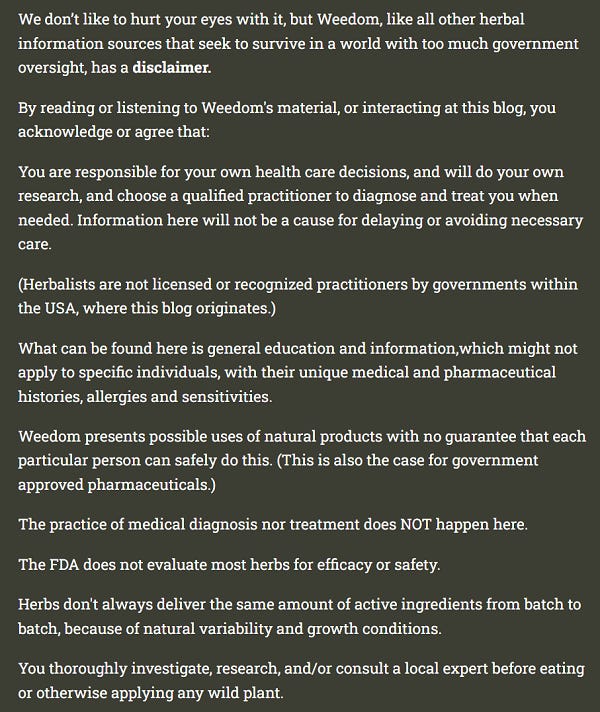
Thanks, Teagan.
Self interest caused dandelions to come to the New World same as the Plantago major type of plantain. Both are hugely beneficial to humans so they planted them. Tell your neighbors how to use the weeds for themselves, and they'll naturally leave some growing for the bees. Send them our way!
Part of what kills environmentalism is those people flying around in private jets tell us that we have to give up things, or give them money to save the environment. Instead, we should be rearranging things synergistically for mutual benefits. Permaculture people are onto something big.
Your knowledge on weeds is continuously surprising. In my neighborhood I’m trying to get people to stop mowing in May and let these superstars have their day in the sun.
But it’s not easy going! Even when you tell people how much the bees need dandelion they still don’t quite get it.
Great work on this one